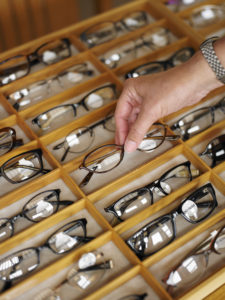Study highlighting the transformative power of reading glasses.
April 10, 2024

Photo credit: Getty Images
A pair of reading glasses increases the earnings of people in low-income communities by 33 percent, according to new research.
A new randomized controlled trial finds that the provision of reading glasses improves livelihoods and quality of life and reduces poverty.
Last week, VisionSpring, BRAC and Queen’s University Belfast released the findings of their THRIVE study – Tradespeople and Hand-workers Rural Initiative for a Vision-enhanced Economy.
THRIVE, carried out across rural Bangladesh, is the first randomized controlled trial to measure the impact of reading glasses on income. The findings are of particular importance because no other health-related intervention has reported an effect size as large for income.
The THRIVE trial involved 824 people from 15 districts of Bangladesh. The study was carried out in communities significantly engaged in farming and artisan crafts and included participants such as teachers, tailors, shopkeepers and mechanics. On average, participants were age 47 and 48 percent female.
THRIVE’s focus on income builds upon the findings of the PROSPER trial VisionSpring undertook, which was the first-ever randomized controlled trial to explore the link between clear vision and productivity.
The results uncover many benefits for first-time wearers of reading glasses across a wide variety of rural occupations:
- Higher earnings – The monthly median income of an individual who received reading glasses increased from US$35.3 to US$47.1 within eight months, a difference of 33.4 percent, whereas the control group showed no increase.
- Returning to work – Income increases were higher among those who were not working at the start of the study, suggesting that reading glasses helped economically inactive people return to work.
- Not just for people who are literate – Reading glasses are not just for people who can read. Only 35 percent of participants in the study were literate. Reading glasses helped participants accomplish work and household tasks such as threading a needle, weaving and sorting grain.
- Quality of life – Wearers experienced a 16 percent improvement on a near-vision quality of life index. The index measures factors such as people’s sense of independence and ease of doing daily tasks, such as reading a mobile phone display and seeing the food they are preparing and eating.
- Widespread blurry vision – The trial found a substantial need for near glasses in this working population; 50 percent of those aged 35-65 years, who had their eyes tested, were identified to have presbyopia, the inability to see close up without help from glasses. This underscores the substantial potential for economic benefit with an inexpensive glasses intervention in this large and important group.
“The THRIVE study reveals that the simple intervention of reading glasses yields outsized impact in terms of income,” said Ella Gudwin, the CEO of VisionSpring. “We encourage governments, philanthropists, development agencies and the private sector to invest in vision correction as livelihood interventions. This evidence-based investment will boost individuals’ earnings as well as generate increased economic output and productivity that is good for communities and the wider economy.”
Other Articles to Explore
More than a billion people globally don’t have the glasses they need to see clearly. Presbyopia is the leading cause of vision impairment globally. Without reading glasses more than 8261 million people have difficulty performing routine tasks and maximizing their income earning potential.
A way forward for vision screening in low- and middle-income countries: task sharing
In addition to measuring the impact of reading glasses on worker income, the study highlighted the opportunity to increase access to vision care by training non-medical personnel, such as community health workers, to conduct basic sight tests and dispense ready-made reading glasses.
All the screenings in the trial were conducted by non-medical personnel, as opposed to optometrists. By demonstrating that reading glasses dispensed by community health workers significantly improved income, THRIVE affirms the efficacy of this approach to improve livelihoods in low-income settings.
Last year the World Health Organization introduced training for community health workers and primary care providers to identify presbyopia, dispense reading glasses and refer for other eye conditions. This is the same task-sharing methodology that VisionSpring and BRAC pioneered in 2002 and was used in this study.
References
1. “The Effect on Income of Providing Near Vision Correction to Workers in Bangladesh,” published in PLOS ONE



























